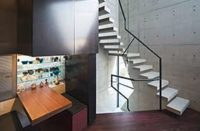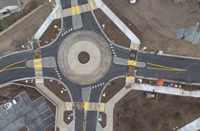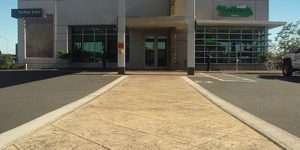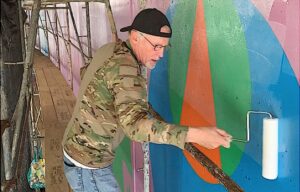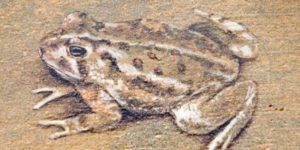Most bridges are built to be purely functional, but functional doesn’t have to mean boring. Decorative concrete contractors have played a key role in some recent artistically striking bridge construction projects. Using materials that add character and can withstand exposure to the outdoors, contractors are transforming concrete bridge decks and support structures from dull and gray to eye-catching.
Materials of choice include stains, overlays and specialty paving systems. Some bridge developers favor integrally colored concrete over concrete coatings, as integral color carries with it less maintenance costs.
Here are eight instances in which decorative concrete applications took bridges from functional to beautiful. Some designs are simple and some come with a story (like the motifs on the Demonbreun Street Viaduct’s piers that salute Nashville’s railroad history), but all of them take travelers from point A to point B in style.
Demonbreun Street Viaduct — Nashville, Tenn.
The 774-foot-long, three-lane Demonbreun Street Viaduct in Nashville, Tenn., pays homage to the city’s railroad heritage by displaying locomotive engine motifs on its poured-in-place concrete support piers. The motifs, which wrap around three sides of each of the piers, are a result of the combined talents of concrete-texturing product manufacturer Scott System Inc., Nashville landscape architecture firm Hawkins Partners Inc., and Brentwood, Tenn.-based Bell & Associates Construction.
Buck Scott, founder of Scott System, said he was contacted by Hawkins Partners architects about creating form liners that would be used to build the bridge’s piers. (The client, the Tennessee Department of Transportation, had called on Hawkins Partners earlier to design the bridge.) Working off the architects’ designs, Scott System employees developed custom form liners made from urethane elastomer and incorporated various surface textures into their designs.
Scott System sold its finished form liners to Bell & Associates Construction, which constructed the piers by placing the liners inside the concrete forms prior to pouring. Workers made a full-size mock-up of one of the piers before Scott System finalized its form liners.
Viewed from the front, each pier looks similar to an oncoming train, and mirroring train engine designs appear on the sides of each pier. Round metal rivets were applied to enhance the fronts.
Scott says the towering height of each completed pier was the toughest part of working on the Demonbreun Street Viaduct.
“The biggest challenge was the size,” Scott says. “The piers were upwards of 24 feet tall, and that’s a big piece of work.”
The Demonbreun Street Viaduct opened in October 2006, replacing a 75-year-old deteriorated bridge that the city closed in 2004. The viaduct, which connects Nashville’s downtown and midtown areas, also holds lanes for bikes and pedestrians.
“It started with a dream, with an idea,” Scott says. “They wanted it to reflect that history of the railroad.”
Antelope Valley Bridges — Lincoln, Neb.
One goal of the city of Lincoln, Neb.’s ongoing revitalization efforts in the Antelope Valley region was to transform five bridges that cross Antelope Creek in downtown Lincoln, as well as spruce up several mezzanine areas and walking and biking paths located along the creek. The material of choice? Five different types of decorative concrete applications, which crews from Todd Rose Decorative Concrete installed over the course of six months.
On each of the five bridges, workers sprayed a texture polymer overlay from Miracote out of a hopper gun onto sides and railings, which matched the look of stucco desired by project managers, says company owner Todd Rose, who is now based in Charleston, S.C.
“They wanted an inexpensive, protective coating that would produce the look of stucco without the high cost, and the spray texture polymer fits that to a T,” Rose says.
On the concrete support structures located underneath each bridge, workers created a wave pattern with Nox-Crete Products Group’s protective Nox-Carb stain in Mocha, Saddle Tan and Sandpiper Beige. They also stained five bridge retaining walls with Nox-Carb in varying wave patterns. Crews stamped 3,000 square feet of concrete walking paths with Murray Decorative Concrete Supply stamps in a cobblestone design, then topped the stamped paths with a Decorative Concrete Impressions color hardener in a dark brown shade.
Workers also sandblasted tens of thousands of square feet of concrete surfaces along Antelope Creek and used stencils from Decorative Concrete Impressions to imprint quotations by Mahatma Gandhi and Martin Luther King Jr. On one sandblasted patio area, workers used a giant stencil to leave an impression of the word “celebrate.”
“This job really showcases decorative concrete and demonstrates how versatile it is,” Rose says. “The job didn’t include any plain concrete, except for a bike path.”
Overseeing the Antelope Valley project was the international construction management firm Parsons Brinckerhoff along with the U.S. Army Corps of Engineers. Two different Lincoln-based architecture firms, Erickson Sullivan Architects and The Clark Enersen Partners, were responsible for designing the wave patterns seen on the bridges and retaining walls.
Rose says he got involved when the city asked his company to fix a coating job that another contractor had previously completed on one of the bridges.
The biggest challenge, he notes, was not the physical job itself but the activities leading up to each phase of the job. With so many organizations and decision makers involved, the planning process proved to be a lengthy one. “There would be meetings every week, and I learned a lot of lessons,” he says.
Todd Rose’s workers completed their leg of the Antelope Valley project last year, and Rose says their work has helped produce a new community gathering space in the city of Lincoln.
“They’re starting to do concerts in the area and people will come and sit in the grass,” Rose says. “It’s all about the community.”
Millers River Bridge — Athol, Mass.
Flowing through the downtown area of the quaint town of Athol, Mass., is the Millers River, the site of a bridge project that has earned Woburn, Mass.-based Donlon Coatings recognition for its staining work.
Donlon Coatings used L. M. Scofield Co.’s Lithochrome Tintura Stain in shades of gray and peach on the two support walls at Millers River Bridge, and earlier this year, the manufacturer awarded Donlon Coatings as second runner-up in its Third Annual Decorative Concrete Awards contest for the project.
Acton, Mass.-based construction company MIG Corp., which hired Donlon Coatings to complete the bridge’s decorative work, built the 120-foot-long steel girder bridge for the Massachusetts Department of Transportation. The two support walls that hang down each side of the bridge are made from concrete formed to resemble fieldstone, for which L. M. Scofield representatives developed a stain color mock-up designed to give the stones a subtle, natural look.
“The process was to stain the formed concrete stones in alternating colors, using three different colors to form a pattern that looked like an actual stone wall,” says Jim Donlon, president and owner of Donlon Coatings.
Donlon Coatings installers, who were led by 25-year industry veteran Phil Harris, were met with an unexpected challenge when they got to work. The general contractor had mistakenly stained both bridge walls a single gray color, so Donlon’s team had to take the walls back to their natural shade prior to carrying out the original staining plan.
“It was kind of a green-gray and we needed to get it back to the original concrete gray before we could duplicate the mock-up,” Donlon says. “Which we did. We were able to get a gray Tintura stain and take (the concrete) closely back to the original color, and then pretty much follow the prescription that L. M. Scofield had laid out.”
Finding the perfect shade to finish correcting the mistake was a trial-and-error process, Donlon says. “We blended colors of greens and grays, and there was a little hint of blue that we put into one of the grays to try to get it to a very natural-looking color. It was a little challenging to come up with a color combination. We made about six or seven mock-ups before we hit on the correct combination, and then carried that out across the bridge.”
After workers stained the formed stones in the initially planned shades of gray and peach, they finished the walls with a coat of Scofield Repello sealer. Donlon Coatings spent approximately three weeks total on the job and completed it in October 2010.
“The folks at Donlon did a great job applying the different colors,” says Dave LaPrade, a project manager with MIG Corp. “I personally feel the décor makes the quality of the workmanship that was put into this project stand out.”
195th Street Bridge — Farmington, Minn.
This bridge, which carries 195th Street across the Canadian Pacific Railroad tracks in Farmington, Minn., is supported by poured-in-place, arched concrete piers with integrally cast thin brick and simulated stone rustications. Installers used Scott System’s Rim Snap system, plastic brick holders that snap together via interlocking tabs and are designed to hold thin brick in place against the inside of a concrete form. Scott System founder Buck Scott says concrete was poured into the form, bonding the bricks, which were then exposed once the form and the reusable Rim Snap system were removed.
Harbor Drive Pedestrian Bridge — San Diego, Calif.
In downtown San Diego, you’ll find an abundance of the Caroll Canyon exposed aggregate finish, a finish dictated by the city’s redevelopment agency, Centre City Development Corp. (CCDC). Now, that finish also appears on the Harbor Drive Pedestrian Bridge, a graceful structure that carries residents and visitors over San Diego’s Harbor Freeway.
San Diego-based Safdie Rabines Architects, the firm responsible for the bridge’s design along with San Francisco-based T.Y. Lin International, selected the Caroll Canyon exposed aggregate finish and a quarried stone sand finish for the bridge deck. Reyes Construction, the general contractor on the project, asked San Diego-based decorative concrete manufacturer and installer T.B. Penick & Sons Inc. to recreate these two paving finishes, but in topping form. The result: T.B. Penick & Sons Specialty Topping System, a poured-in-place system the company developed especially for the bridge.
“The goal was to match CCDC, which has specific paving in downtown San Diego,” says Chris Klemaske, project developer for T.B. Penick & Sons. “Achieving both finishes in a 3/4-inch topping and, in addition to that, on a bridge structure was a challenge.”
The 550-foot-long bridge spans the waterfront area of San Diego and is one of the world’s longest pedestrian suspension bridges. The bridge is curved and supported by slanted cables on one side, creating a shape that mimics that of a sailboat, Klemaske notes. The bridge is owned by both CCDC and the Unified Port of San Diego.
The walking surface holds perfectly aligned saw cuts that define squares and rectangles, and surface textures and colors vary from a grainy, dark beige to a smoother, pale beige. Architects say T.B. Penick & Sons’ topping gave them the leeway they needed during the design process.
“The concrete topping used on the Harbor Drive Pedestrian Bridge was used due to the material’s thin section and inherent light weight,” says Eric Lindebak, principal at Safdie Rabines Architects. “This material also allowed us the flexibility to vary the color, texture and scoring patterns in the horizontal plane that provide necessary scale, refinement and relationship to the bridge geometry.”
Workers had to grind down some areas of the bridge’s surface to allow for the 3/4-inch topping, Klemaske says. Then, they installed approximately 6,600 square feet of topping material in small, controlled pours. Achieving superb precision was the biggest challenge installers faced, she adds.
“If you look at the span of the bridge, you’ll see that those control joints in between each pour and the saw cuts had to be perfect,” Klemaske says. “Being precise was so critical.”
The bridge opened in early 2011 and has been met with praise, including several awards. “It looks beautiful,” Klemaske says.
Brickell Key Bridge — Miami, Fla.
The deteriorating Brickell Key Bridge, which connects downtown Miami to the 44-acre island of Brickell Key, underwent an extensive restoration this year courtesy of products from Mapei.
Installers began the project by repairing the damaged bridge deck and the underside of the bridge with three types of repair mortars: Planitop 18, Planitop XS and Planitop 15.
The deck was shotblasted and coated with an epoxy overlay broadcast system, which consisted of two coats of Mapei’s Planiseal Traffic Coat. Both coats were seeded with an approved “black beauty slag” aggregate, per the owners approval. This waterproofing system provides superior durability and excellent skid resistance while delivering an aesthetically pleasing finished appearance on the 812-foot-long surface.
“The addition of ‘black beauty’ aggregate not only created a highly attractive finish, but effectively complemented this highly impermeable system that is capable of arresting carbonation and penetration of chloride ions into the concrete deck,” states Mapei CRS product manager Roger Pratt in his recent article in Realtà Mapei Americas magazine.
Cliff Street Pedestrian Bridge — Solana Beach, Calif.
This pedestrian bridge in Solana Beach, Calif., features related words in English and Spanish, such as “shell – concha,” and a beach-like finish in blue and beige shades that were achieved with Lithocrete, a patented paving system that allows artisans to embed eye-catching aggregates into reinforced concrete. This project incorporates a combination of glass and seashells. San Diego-based T.B. Penick & Sons Inc. installed the Lithocrete system, then added the lettering through sandblasting and staining work.
Rosa Street Pedestrian Bridge — Solana Beach, Calif.
The surface of this Solana Beach, Calif., pedestrian bridge, installed by San Diego-based T.B. Penick & Sons Inc., was inspired by the colors of the Solana Beach sunset, says T.B. Penick project developer Chris Klemaske. Installers used the Lithocrete concrete paving system, embedding glass in shades of red, orange and yellow. There’s even a burst of green glass pieces in a corner, which Klemaske says represents the “green flash,” a phenomenon known among locals as a flash of green that can be spotted in the sky as the sun sets.
